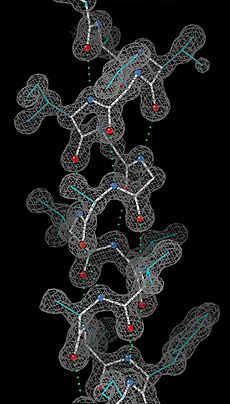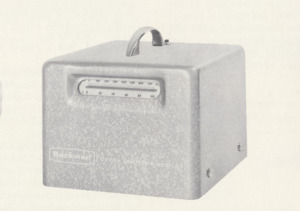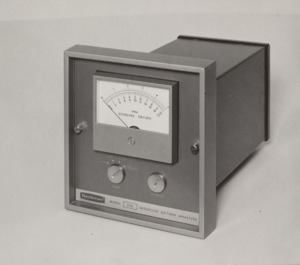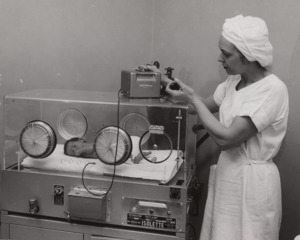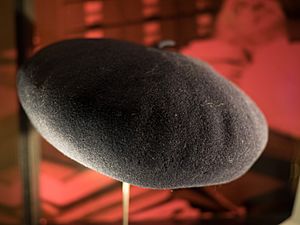Linus Pauling facts for kids
Quick facts for kids
Linus Pauling
|
|
|---|---|
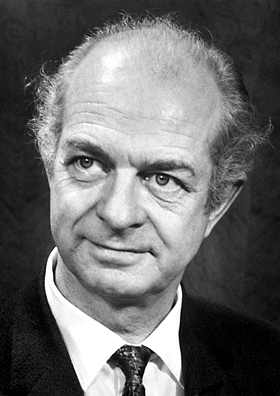
Pauling in 1962
|
|
| Born |
Linus Carl Pauling
February 28, 1901 Portland, Oregon, U.S.
|
| Died | August 19, 1994 (aged 93) Big Sur, California, U.S.
|
| Education | |
| Known for |
See list
|
| Spouse(s) |
Ava Helen Miller
(m. 1923; died 1981) |
| Children | 4 |
| Awards |
|
| Scientific career | |
| Fields | |
| Institutions |
As faculty member
As fellow
Cornell University (1937–1938)
University of Oxford (1948) Center for the Study of Democratic Institutions (1963–1967) |
| Thesis | The Determination with X-Rays of the Structures of Crystals (1925) |
| Doctoral advisor |
|
| Other academic advisors | |
| Doctoral students |
|
| Signature | |
 |
|
| Notes | |
|
The only person to win two unshared Nobel Prizes.
|
|
Linus Carl Pauling (February 28, 1901 – August 19, 1994) was an amazing American scientist. He was a chemist, biochemist, and chemical engineer. He was also a peace activist, author, and teacher.
Pauling wrote over 1,200 papers and books. About 850 of these were about science. New Scientist magazine called him one of the 20 greatest scientists ever. By the year 2000, he was ranked the 16th most important scientist in history.
He won the Nobel Prize in Chemistry in 1954 for his science work. He also won the Nobel Peace Prize in 1962 for working for peace. He is one of only five people to win more than one Nobel Prize. He is the only person to win two Nobel Prizes by himself, without sharing them. He is also one of two people to win Nobel Prizes in different fields. The other person was Marie Curie.
Pauling helped start the fields of quantum chemistry and molecular biology. He explained how atoms connect to each other, a process called chemical bonding. He also helped us understand the structures of important molecules in living things. His discoveries helped other scientists figure out the structure of DNA. This was a huge step in understanding how all living things are made.
Later in his life, Pauling spoke out for nuclear disarmament. This means getting rid of nuclear weapons. He also promoted ideas about using large amounts of vitamin C for health. He was married to Ava Helen Pauling, who was also a human rights activist.
Contents
Linus Pauling's Early Life and Education
Linus Carl Pauling was born on February 28, 1901. He was the first child of Herman Henry William Pauling and Lucy Isabelle "Belle" Darling. He was born in Portland, Oregon. His name, Linus Carl, honored his grandfathers. His family had German and English roots.
In 1902, his sister Pauline was born. His parents moved to find a bigger and cheaper home. His father, Herman, worked as a traveling salesman. Later, he opened his own drugstore.
In 1905, the family moved to Condon, Oregon. Sadly, Herman Pauling died in 1910 when Linus was only nine years old. His mother, Lucy, was left to care for Linus and his two younger sisters.
Linus became interested in chemistry because of a friend, Lloyd A. Jeffress. Lloyd had a small chemistry lab kit. Pauling later wrote that he was "entranced by chemical phenomena." He loved seeing how different substances appeared from reactions. He wanted to learn more about the world this way.
In high school, Pauling did chemistry experiments. He found equipment and materials from an old steel plant. He even tried to start a business with a friend. They offered to test butterfat for dairies. But the dairymen didn't trust two boys with the job, so the business failed.
When he was 15, Pauling had enough credits to go to Oregon State University (OSU). He was missing two American history courses for his high school diploma. The principal wouldn't let him take them at the same time. So, Pauling left high school without a diploma. Forty-five years later, after he won two Nobel Prizes, the school gave him an honorary diploma.
Pauling worked many jobs to save money for college. He worked at a grocery store and as an apprentice machinist. He also set up a photography lab with friends. In September 1917, he was accepted into Oregon State University. He quit his machinist job and told his mother. She didn't see the point of a university education.
College Years and Discoveries

In his first semester, Pauling took chemistry, math, and other courses. He was active on campus and started a fraternity chapter. After his second year, he planned to work to support his mother. But the college offered him a job teaching chemistry. He worked 40 hours a week and earned enough to continue his studies.
In his last two years, Pauling learned about the work of Gilbert N. Lewis and Irving Langmuir. They studied how atoms are built and how they form molecules. Pauling decided to focus on how the properties of substances relate to their atomic structure. He became one of the first scientists in a new field called quantum chemistry.
Pauling met his future wife, Ava Helen Miller, in a chemistry class he taught. He graduated in 1922 with a degree in chemical engineering. He then went to California Institute of Technology (Caltech) for graduate school. He used X-ray crystallography to study the structure of crystals. He earned his PhD in 1925.
Linus Pauling's Career and Scientific Breakthroughs
In 1926, Pauling traveled to Europe on a special scholarship. He studied with famous physicists like Arnold Sommerfeld and Niels Bohr. These scientists were experts in the new field of quantum mechanics. Pauling became very interested in how quantum mechanics could explain the structure of atoms and molecules. He spent two years on this work. He became a pioneer in using quantum theory to understand molecules.
In 1927, Pauling became a professor at Caltech. He continued his X-ray studies and did quantum calculations. He published about 50 papers in five years. He also created "Pauling's rules" for predicting crystal structures. By 1930, he was a full professor. In 1931, he won a major award for his work. The next year, he published his most important paper. In it, he explained how atomic orbitals combine, a concept called hybridization. This helped explain how carbon atoms bond.
Pauling also became friends with physicist J. Robert Oppenheimer. They planned to work together on chemical bonds. But their friendship ended when Oppenheimer tried to get Pauling's wife, Ava Helen, to go to Mexico with him. She refused and told Pauling, who then stopped working with Oppenheimer.
In 1930, Pauling went to Europe again. He learned about using electron diffraction to study gases. When he returned, he built an electron diffraction tool at Caltech. He used it to study the shapes of many chemical substances.
In 1932, Pauling introduced the idea of electronegativity. This is a measure of how strongly an atom attracts electrons in a chemical bond. He created a scale for most elements. This scale helps predict how atoms will bond together.
In 1936, Pauling became the head of the Chemistry and Chemical Engineering Division at Caltech. He held this position until 1958.
Understanding Chemical Bonds
In the late 1920s, Pauling started publishing papers about the chemical bond. From 1937 to 1938, he taught at Cornell University. There, he gave many lectures and finished his famous book, The Nature of the Chemical Bond.
This book was so important that he won the Nobel Prize in Chemistry in 1954. The prize was "for his research into the nature of the chemical bond." His book is considered "chemistry's most influential book of this century." Even today, scientists still refer to it.
One of Pauling's key ideas was orbital hybridization. He showed that atomic orbitals can mix together. This creates new "hybrid" orbitals that better explain how atoms bond in molecules. For example, carbon atoms can form four equal bonds, like in methane.
He also explained the difference between ionic bonds and covalent bonds. In ionic bonds, electrons are transferred. In covalent bonds, electrons are shared. Pauling showed that most bonds are somewhere in between. His electronegativity concept helps predict how much a bond is ionic or covalent.
Pauling also studied aromatic hydrocarbons, like benzene. He showed that benzene's structure is a mix of different possible structures. He called this idea "resonance." It means the electrons are spread out over the molecule, making it very stable.
Ionic Crystal Structures
In 1929, Pauling published five rules. These rules help scientists predict and explain the structures of ionic compounds. These rules are still used today to understand how atoms arrange themselves in crystals.
Discovering Biological Molecules
In the mid-1930s, Pauling became interested in molecules important for life. He worked with famous biologists at Caltech. He studied hemoglobin, the protein in red blood cells that carries oxygen. He found that hemoglobin changes its shape when it picks up or drops off oxygen. This made him want to study proteins more deeply.
Proteins are complex, so studying them with X-rays was hard. But Pauling kept working on it. In 1951, Pauling and his team proposed two main shapes for proteins: the alpha helix and the beta sheet. These shapes are like spirals and folded sheets. They are fundamental to how proteins work.
Pauling also tried to figure out the structure of DNA. He thought it was a triple helix. However, his model had some mistakes. Meanwhile, James Watson and Francis Crick were also working on DNA. They used information from Maurice Wilkins and Rosalind Franklin's X-ray images. In 1953, Watson and Crick found the correct structure: the DNA double helix.
Pauling later explained why he made a mistake. He didn't have the best X-ray images. Rosalind Franklin had the best images, but Pauling didn't see them before he published his incorrect model. He was also prevented from traveling to a conference where he might have seen them. This was due to political reasons at the time.
Pauling also studied how enzymes work. He suggested that enzymes help reactions happen by making the reaction's "transition state" stable. He also believed that antibodies fit with antigens like a lock and key.
Molecular Genetics and Disease
In 1949, Pauling and his colleagues published a paper about sickle cell disease. They showed that this disease is caused by an abnormal protein in red blood cells. This was the first time a human disease was understood at the molecular level. It was a huge step for molecular genetics.
This success led Pauling to think that other diseases, even mental illnesses, might also be caused by problems with genes. He encouraged research into how chemistry and biology could help understand mental illness.
Linus Pauling's Activism
Wartime Contributions
Before World War II, Pauling wasn't very involved in politics. During the war, he worked on military research. He designed the Pauling oxygen meter. This device could measure oxygen in submarines and airplanes. After the war, it was used in incubators for premature babies.
He also worked on finding a substitute for human blood plasma for transfusions. His team developed a substance called polyoxy gelatin. For his important work during the war, he received a special medal from President Harry S. Truman.
Working for Nuclear Peace
The invention of the atomic bomb and his wife Ava's peaceful beliefs changed Pauling. He became a strong peace activist. In 1946, he joined a group led by Albert Einstein. Their goal was to warn people about the dangers of nuclear weapons.
Because of his political activism, the US government denied him a passport in 1952. He was invited to speak at a science conference in London. After public outcry, he was given a limited passport. His full passport was returned in 1954, just before he received his first Nobel Prize.
In 1955, he signed the Russell-Einstein Manifesto. This was a statement from leading scientists calling for peace and nuclear disarmament. He also supported the Mainau Declaration, signed by 52 Nobel Prize winners.
In 1957, Pauling started a petition with scientist Barry Commoner. They asked scientists to stop nuclear testing. In 1958, Pauling and his wife gave a petition to the United Nations. It had over 11,000 signatures from scientists in 50 countries. It called for an end to nuclear weapons testing.
Pauling also debated physicist Edward Teller on TV about the dangers of nuclear fallout. In 1958, Pauling published a book called No more war!. In it, he called for an end to nuclear testing and all wars. He suggested creating a World Peace Research Organization.
Pauling supported a study that measured radioactive strontium-90 in children's baby teeth. This "Baby Tooth Survey" showed that above-ground nuclear testing was spreading dangerous radioactive fallout. This research helped create public pressure.
This pressure led to a ban on above-ground nuclear weapons testing. In 1963, the Partial Test Ban Treaty was signed by John F. Kennedy and Nikita Khrushchev. On the day the treaty began, Pauling was awarded the Nobel Peace Prize for 1962. The Nobel Committee praised his constant work against nuclear weapons and war. Pauling said his wife, Ava, deserved the prize with him.
Facing Political Criticism
Many people, including other scientists, disagreed with Pauling's political views. Some thought he was too supportive of Soviet communism. In 1960, he was questioned by a US Senate committee. A magazine even called his 1962 Nobel Prize "A Weird Insult from Norway."
Pauling sued a magazine for calling him a "fellow traveler" of communists. He lost the lawsuit. His peace activism also caused problems at Caltech. In 1958, he was asked to step down as head of the Chemistry Division. He later resigned from Caltech after receiving his Nobel Peace Prize money. He then worked at other universities, including Stanford.
Vietnam War Activism
In the 1960s, Pauling strongly opposed the Vietnam War. He said the war was wrong and against the US Constitution. He gave speeches, signed protest letters, and even wrote to the North Vietnamese leader, Ho Chi Minh. His efforts were not listened to by the American government.
In 1970, Pauling received the Lenin Peace Prize from the USSR. He continued his peace work for many years. He and Ava helped start the International League of Humanists.
Linus Pauling's Medical Research
Vitamin C Advocacy
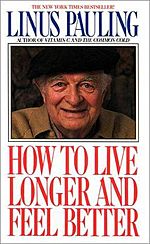
In 1941, Pauling was diagnosed with a kidney disease. He believed he controlled it with a special diet and vitamin supplements. This positive experience made him interested in using vitamins to treat diseases.
In 1965, Pauling read a book about using niacin for mental health. He thought vitamins might have important effects beyond preventing vitamin deficiencies. In 1968, he wrote a paper called "Orthomolecular psychiatry." He suggested that giving people the right amounts of natural substances in the brain could help treat mental illness. Pauling created the term "orthomolecular" for this idea. This approach is not widely accepted by mainstream doctors.
In 1973, Pauling started the Linus Pauling Institute. He researched vitamin C and continued his work in chemistry and physics. He became very interested in how vitamin C might prevent heart disease. He suggested that high doses of vitamin C and lysine could help.
Pauling's work on vitamin C caused a lot of debate. He started taking 3 grams of vitamin C every day to prevent colds. He wrote a book in 1970 called Vitamin C and the Common Cold. He also worked with a cancer surgeon, Ewan Cameron, on using vitamin C as a cancer treatment. They wrote papers and a book, Cancer and Vitamin C. Pauling claimed that vitamin C could increase survival for very sick cancer patients.
However, later studies by the Mayo Clinic found that high-dose vitamin C did not help treat cancer. They also found it was no better than a placebo for cancer. The medical community concluded that Pauling's claims about vitamin C for colds or cancer were not proven. Pauling disagreed with these studies. He said they used the wrong methods, like giving vitamin C by mouth instead of by IV. He also said the studies were too short.
Despite the negative findings, Pauling continued to promote vitamin C for cancer and colds. He worked with groups to use vitamin C for children with brain injuries. While some studies today suggest more research is needed, most trials show that vitamin C supplements alone do not prevent cancer.
Linus Pauling's Personal Life
Pauling married Ava Helen Miller on June 17, 1923. Their marriage lasted until Ava's death in 1981. They had four children: Linus Carl Jr., Peter, Edward Crellin, and Linda Helen. His children became a psychiatrist, a crystallographer, a biologist, and his daughter married a geologist.
Pauling was raised in the Lutheran Church. Later, he joined the Unitarian Universalist Church. Two years before he died, he said he was an atheist.
In 1960, Pauling got lost while walking near the coast in California. He tried to climb a cliff and got stuck about 300 feet above the ocean. He spent a sleepless night there before being found almost 24 hours later.
Death and Lasting Impact
Linus Pauling died from prostate cancer on August 19, 1994. He was 93 years old. He is buried with his wife in Lake Oswego, Oregon.
Pauling's discoveries had a huge impact on many areas of science. He published about 350 papers on topics like quantum mechanics, chemistry, protein structure, and medicine.
His work on chemical bonding made him one of the founders of modern quantum chemistry. His book The Nature of the Chemical Bond was a key textbook for many years. Ideas like hybridization and electronegativity are still taught in chemistry classes today. His discovery of the alpha helix and beta sheet is a basic part of understanding protein structure.
Francis Crick, who helped discover DNA, called Pauling the "father of molecular biology". Pauling's discovery that sickle cell disease was a "molecular disease" opened the door to studying genetic problems at a tiny, molecular level.
In 2017, Pauling's 1951 paper on protein structure was honored as a "Chemical Breakthrough Award."
How Linus Pauling is Remembered
Oregon State University built the Linus Pauling Science Center. It's a large building for chemistry classes and labs.
On March 6, 2008, the United States Postal Service released a stamp honoring Pauling. It recognized his work on chemical bonds and his role in molecular biology. He was also honored for his work on sickle cell anemia.
In 2008, Pauling was inducted into the California Hall of Fame. His son accepted the honor for him. In Oregon, February 28 is named "Linus Pauling Day." The Linus Pauling Institute is now part of Oregon State University. The university's library also holds many of Pauling's papers and research notebooks.
Caltech also has a Linus Pauling Lecture Hall. Other places named after him include streets, a middle school, and even a small airport. An asteroid, 4674 Pauling, was named after him on his 90th birthday. Linus Torvalds, who created the Linux computer system, was also named after Pauling.
Awards and Honors
Linus Pauling received many awards and honors throughout his life:
- 1931 ACS Award in Pure Chemistry
- 1931 Irving Langmuir Award
- 1940 Alpha Chi Sigma
- 1941 Nichols Medal
- 1946 Willard Gibbs Award
- 1947 Davy Medal
- 1947 T. W. Richards Medal
- 1948 Presidential Medal for Merit
- 1948 Foreign Member of the Royal Society of London
- 1951 Gilbert N. Lewis medal
- 1952 Pasteur Medal
- 1954 Nobel Prize in Chemistry
- 1955 Addis Medal
- 1955 John Phillips Memorial Award
- 1956 Avogadro Medal
- 1957 Paul Sabatier Medal
- 1957 Pierre Fermat Medal in Mathematics
- 1957 International Grotius Medal
- 1959 Messenger Lectureship
- 1960 Fellow, Royal Society of Arts
- 1961 Humanist of the Year
- 1961 Gandhi Peace Award
- 1962 Nobel Peace Prize
- 1965 Medal, Academy of the Rumanian People's Republic
- 1966 Linus Pauling Award
- 1966 Silver Medal, Institute of France
- 1966 Supreme Peace Sponsor, World Fellowship of Religion
- 1967 Washington A. Roebling Medal
- 1972 Lenin Peace Prize
- 1974 National Medal of Science
- 1978 Lomonosov Gold Medal
- 1979 Gold Medal Honoree, National Institute of Social Sciences
- 1979 NAS Award in Chemical Sciences
- 1979 Golden Plate Award
- 1981 John K. Lattimer Award
- 1984 Priestley Medal
- 1984 Award for Chemistry, Arthur M. Sackler Foundation
- 1986 Lavoisier Medal
- 1987 Award in Chemical Education
- 1989 Vannevar Bush Award
- 1990 Richard C. Tolman Medal
- 1992 Daisaku Ikeda Medal
- 2008 "American Scientists" U.S. postage stamp series
Images for kids
-
Pauling's graduation photo from Oregon State University, 1922
-
Pauling's book, How to Live Longer and Feel Better, suggested taking a lot of Vitamin C.
See also
 In Spanish: Linus Pauling para niños
In Spanish: Linus Pauling para niños
- List of peace activists
- Niacin





